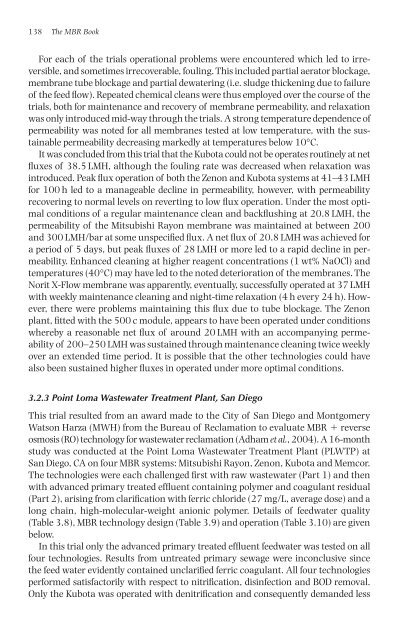The MBR Book: Principles and Applications of Membrane
The MBR Book: Principles and Applications of Membrane
The MBR Book: Principles and Applications of Membrane
Create successful ePaper yourself
Turn your PDF publications into a flip-book with our unique Google optimized e-Paper software.
138 <strong>The</strong> <strong>MBR</strong> <strong>Book</strong><br />
For each <strong>of</strong> the trials operational problems were encountered which led to irreversible,<br />
<strong>and</strong> sometimes irrecoverable, fouling. This included partial aerator blockage,<br />
membrane tube blockage <strong>and</strong> partial dewatering (i.e. sludge thickening due to failure<br />
<strong>of</strong> the feed flow). Repeated chemical cleans were thus employed over the course <strong>of</strong> the<br />
trials, both for maintenance <strong>and</strong> recovery <strong>of</strong> membrane permeability, <strong>and</strong> relaxation<br />
was only introduced mid-way through the trials. A strong temperature dependence <strong>of</strong><br />
permeability was noted for all membranes tested at low temperature, with the sustainable<br />
permeability decreasing markedly at temperatures below 10°C.<br />
It was concluded from this trial that the Kubota could not be operates routinely at net<br />
fluxes <strong>of</strong> 38.5 LMH, although the fouling rate was decreased when relaxation was<br />
introduced. Peak flux operation <strong>of</strong> both the Zenon <strong>and</strong> Kubota systems at 41–43 LMH<br />
for 100 h led to a manageable decline in permeability, however, with permeability<br />
recovering to normal levels on reverting to low flux operation. Under the most optimal<br />
conditions <strong>of</strong> a regular maintenance clean <strong>and</strong> backflushing at 20.8 LMH, the<br />
permeability <strong>of</strong> the Mitsubishi Rayon membrane was maintained at between 200<br />
<strong>and</strong> 300 LMH/bar at some unspecified flux. A net flux <strong>of</strong> 20.8 LMH was achieved for<br />
a period <strong>of</strong> 5 days, but peak fluxes <strong>of</strong> 28 LMH or more led to a rapid decline in permeability.<br />
Enhanced cleaning at higher reagent concentrations (1 wt% NaOCl) <strong>and</strong><br />
temperatures (40°C) may have led to the noted deterioration <strong>of</strong> the membranes. <strong>The</strong><br />
Norit X-Flow membrane was apparently, eventually, successfully operated at 37 LMH<br />
with weekly maintenance cleaning <strong>and</strong> night-time relaxation (4 h every 24 h). However,<br />
there were problems maintaining this flux due to tube blockage. <strong>The</strong> Zenon<br />
plant, fitted with the 500 c module, appears to have been operated under conditions<br />
whereby a reasonable net flux <strong>of</strong> around 20 LMH with an accompanying permeability<br />
<strong>of</strong> 200–250 LMH was sustained through maintenance cleaning twice weekly<br />
over an extended time period. It is possible that the other technologies could have<br />
also been sustained higher fluxes in operated under more optimal conditions.<br />
3.2.3 Point Loma Wastewater Treatment Plant, San Diego<br />
This trial resulted from an award made to the City <strong>of</strong> San Diego <strong>and</strong> Montgomery<br />
Watson Harza (MWH) from the Bureau <strong>of</strong> Reclamation to evaluate <strong>MBR</strong> � reverse<br />
osmosis (RO) technology for wastewater reclamation (Adham et al., 2004). A 16-month<br />
study was conducted at the Point Loma Wastewater Treatment Plant (PLWTP) at<br />
San Diego, CA on four <strong>MBR</strong> systems: Mitsubishi Rayon, Zenon, Kubota <strong>and</strong> Memcor.<br />
<strong>The</strong> technologies were each challenged first with raw wastewater (Part 1) <strong>and</strong> then<br />
with advanced primary treated effluent containing polymer <strong>and</strong> coagulant residual<br />
(Part 2), arising from clarification with ferric chloride (27 mg/L, average dose) <strong>and</strong> a<br />
long chain, high-molecular-weight anionic polymer. Details <strong>of</strong> feedwater quality<br />
(Table 3.8), <strong>MBR</strong> technology design (Table 3.9) <strong>and</strong> operation (Table 3.10) are given<br />
below.<br />
In this trial only the advanced primary treated effluent feedwater was tested on all<br />
four technologies. Results from untreated primary sewage were inconclusive since<br />
the feed water evidently contained unclarified ferric coagulant. All four technologies<br />
performed satisfactorily with respect to nitrification, disinfection <strong>and</strong> BOD removal.<br />
Only the Kubota was operated with denitrification <strong>and</strong> consequently dem<strong>and</strong>ed less



